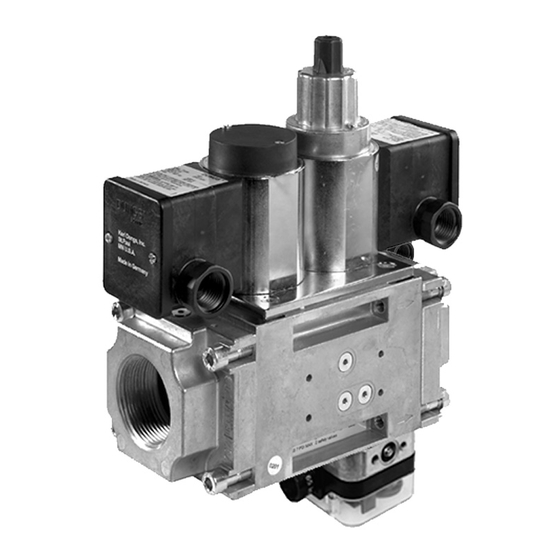Dungs DMV-D/634 Manuale di istruzioni per l'installazione - Pagina 6
Sfoglia online o scarica il pdf Manuale di istruzioni per l'installazione per Unità di controllo Dungs DMV-D/634. Dungs DMV-D/634 9. Dual modular nema 4x safety shutoff valves with proof of closure

Valve Leakage Test
This leak test procedure tests the external sealing and valve
seat sealing capabilities of the DMV automatic safety shutoff
valve. Only qualified personnel should perform this test.
It is required that this test be done on the initial system startup,
and then repeated at least annually. Possibly more often de-
pending on the application, environmental parameters, and
the requirements of the authority having jurisdiction.
Setup
This test requires the following:
A) Test nipples installed in the downstream pressure tap port
of each automatic safety shutoff valve to make the required
1/4" hose connection in step 4.
B) A transparent glass of water filled at least 1 inch from the
bottom.
C) A proper leak test tube. An aluminum or copper 1/4" rigid
tube with a 45˚ cut at the end that is then connected to a
1/4" flexible hose of some convenient length provides for
a more accurate leakage measurement.
However, a 45˚ cut at the end of the 1/4" flexible hose will
suffice, but it will not likely be as accurate as the rigid tube.
D) For detecting external leakages, an all purpose liquid leak
detector solution is required.
Leak Test Procedure
Use the illustration below as a reference.
1. With the upstream ball valve open, the downstream ball
valve closed and both valves energized, apply an all pur-
pose liquid leak detector solution to the "External Leak-
age Test Areas" indicated in the illustration below, to any
accessories mounted to the safety valve, and to all gas
piping and gas components downstream the equipment
isolation valve, and the inlet and outlet gas piping of the
automatic safety shutoff valve. The presence of bubbles
Type
DMV-D(LE) 704/6x4
*Based on air and test conditions per UL 429 Section 29. (Air or inert gas at a pressure of 1/4 psig and also at a pressure of one and one-half times
maximum operating pressure differential, but not less than 1/2 psig. This test shall be applied with the valve installed in its intended position.)
Volume of bubble defined in Table 2 of FCI 70-2-1998.
Allowable Valve Seat
Leakage* up to 7 PSI inlet
628 cc/hr
indicates a leak, which needs to be rectified before pro-
ceeding.
2. Then, de-energize the burner system and verify that both
automatic safety shutoff valves are closed.
3. Close the upstream and downstream manual ball valve.
4. Using a screwdriver, slowly open the V1 test nipple (port 3
or port 4 ) by turning it counter clockwise to depressurize
the volume between the two valves, and connect the 1/4"
flexible hose to the test nipple.
5. Slowly open the upstream manual ball valve, and then
provide for some time to allow potential leakage to charge
the test chamber before measuring the valve seat leakage.
6. Immerse the 1/4 in. tube vertically 1/2 in. (12.7 mm) below
the water surface. If bubbles emerge from the 1/4" tube
and after the leakage rate has stabilized, count the number
of bubbles appearing during a 10 second period. (See
chart below for allowable leakage rates.)
7. Repeat the same procedure for valve V2 (port 5), except
that valve #1 needs to be opened.
After completing the above tests proceed as follows:
8. Verify that the downstream manual ball valve is closed,
and both automatic safety shutoff valves are de-ener-
gized.
9. Remove the flexible hose, and close all test nipples.
10. With the upstream manual ball valve open, energize both
automatic safety shutoff valves.
11. Use soapy water to leak test all test nipples to ensure that
there are no leaks.
12. If no leakage is detected, de-energize all automatic safety
shutoff valves, and open the downstream manual ball
valve.
If leakage values are exceeded, replace valve
immediately.
1/4" Flex Hose
1/4" Rigid Tube
G 1/8" Test Nipple
# 219008
# of Bubbles in 10 s
Air
12
Natural Gas
LP
15
9
6 ... 9
